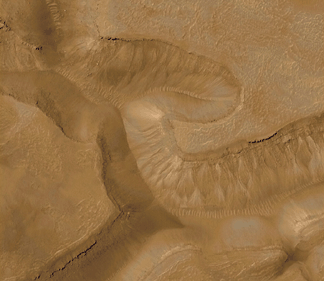![]()
|
In order to understand how our Solar System formed and its relationship to the rest of the universe, it is important that we explore beyond Earth's boundaries. Satellites allow us to investigate space objects that Earth-bound instruments cannot. As an example of the beneficial knowledge that satellites have provided, let's look at the recent findings of the Mars Global Surveyor, a satellite currently in orbit around the Red Planet. |
Using the Mars Orbiter Camera that is aboard Surveyor, scientists have discovered the existence of gullies on the Martian surface which are believed to have formed in the recent past as a result of flowing water. These gullies, or channels, may also be an indicator that there is still water somewhere below the Martian surface. Further studies are necessary before any conclusions can be reached, but for the first time scientists have found possible evdence of "recent" water on Mars. If water is found, then Mars meets all of the environmental requirements to support life, whether it is the smallest of microbes or the largest of mammals. Without satellites we would have none of this valuable information, and consequently we would be no closer to answering some of the many questions that abound in space science today.
How recent is "recent"? The small martian gullies discovered in the pictures of certain craters, troughs, and valleys appear to be "geologically" young. This means that, on the scale of a planet that is 4.5 billion years old, the gullies may be only a few million, or less, years old. The youth of these gullies relative to the history of Mars is indicated by the lack of impact craters--formed by meteors--these features. However, other evidence suggests that the gullies may, in many cases, be much younger than a few million years--in fact, some might be actively seeping water in modern times.

The image seen above was taken by the Surveyor MOC camera and shows a series of troughs and layered mesas in the Gorgonum Chaos region of the martian southern hemisphere. Gullies proposed to have been formed by seeping ground water come out from a specific layer of soil near the tops of trough walls, particularly on south-facing slopes (south is toward the bottom of each picture). This picture was taken on January 22, 2000. The photographed region is of an area 3 kilometers wide by 2.6 km high.

The picture above, called "Apron Covering Dunes," shows a deep, prominent martian gully in a in a region called Nirgal Vallis. Sunlight illuminates the scene from the upper left. At the bottom of the picture is a series of evenly-spaced ridges. These ridges are dunes created by windblown sand. The apron--the fanlike deposit at the lower end of the deep channel-- is seen covering some of the dunes. The sand dunes are thus older than the apron of debris that came from the channel. The dune field has no small meteor impact craters on it, so it, like the gully landforms, is geologically young--yet older than the apron. If the dunes are active in the modern environment--which is uncertain despite the apparent youth of the dunes--then the apron would have had to form within the past few centuries or less. This picture was taken in September 1999.
![]()
The StarChild site is a service of the High Energy Astrophysics Science Archive Research Center (HEASARC), within the Astrophysics Science Division (ASD) at NASA/ GSFC.
StarChild Authors: The StarChild Team
StarChild Graphics & Music: Acknowledgments
StarChild Project Leader: Dr. Laura A.
Whitlock
Curator:
Responsible NASA Official: